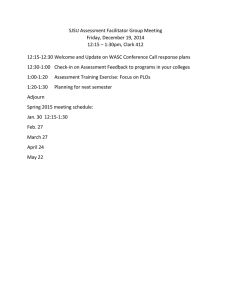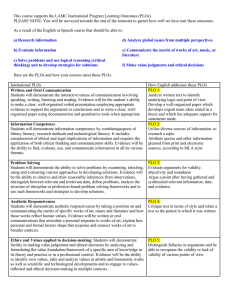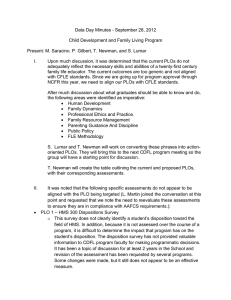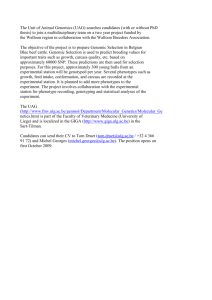SJSU Annual Program Assessment Form Academic Year 2013-2014
advertisement
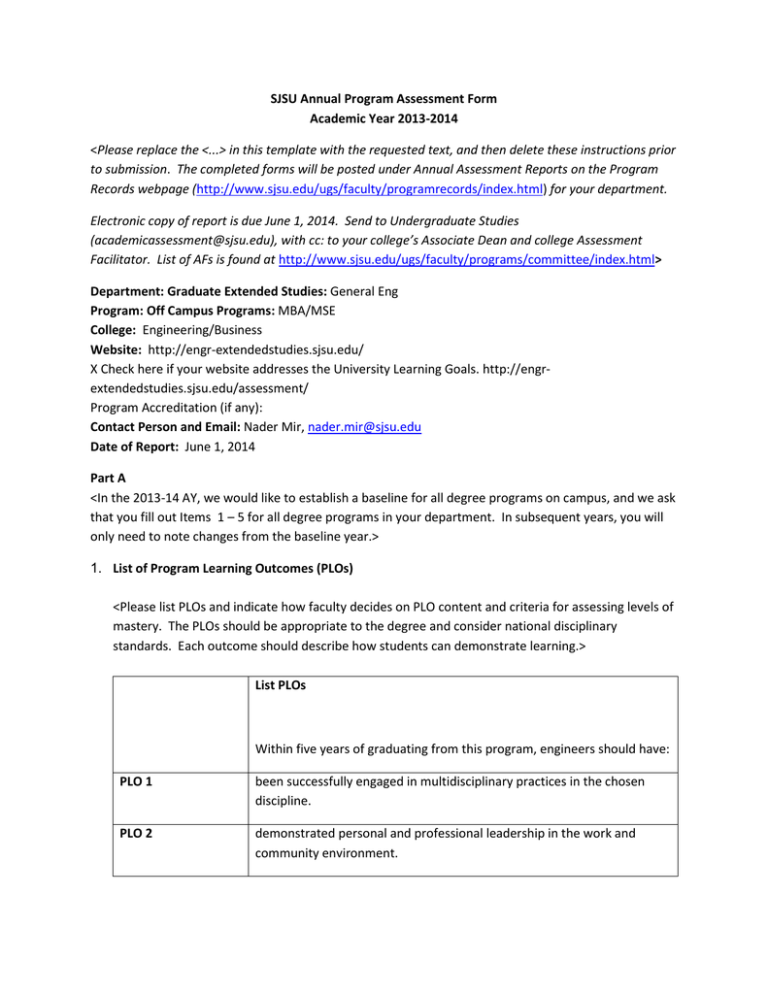
SJSU Annual Program Assessment Form Academic Year 2013-2014 <Please replace the <...> in this template with the requested text, and then delete these instructions prior to submission. The completed forms will be posted under Annual Assessment Reports on the Program Records webpage (http://www.sjsu.edu/ugs/faculty/programrecords/index.html) for your department. Electronic copy of report is due June 1, 2014. Send to Undergraduate Studies (academicassessment@sjsu.edu), with cc: to your college’s Associate Dean and college Assessment Facilitator. List of AFs is found at http://www.sjsu.edu/ugs/faculty/programs/committee/index.html> Department: Graduate Extended Studies: General Eng Program: Off Campus Programs: MBA/MSE College: Engineering/Business Website: http://engr-extendedstudies.sjsu.edu/ X Check here if your website addresses the University Learning Goals. http://engrextendedstudies.sjsu.edu/assessment/ Program Accreditation (if any): Contact Person and Email: Nader Mir, nader.mir@sjsu.edu Date of Report: June 1, 2014 Part A <In the 2013-14 AY, we would like to establish a baseline for all degree programs on campus, and we ask that you fill out Items 1 – 5 for all degree programs in your department. In subsequent years, you will only need to note changes from the baseline year.> 1. List of Program Learning Outcomes (PLOs) <Please list PLOs and indicate how faculty decides on PLO content and criteria for assessing levels of mastery. The PLOs should be appropriate to the degree and consider national disciplinary standards. Each outcome should describe how students can demonstrate learning.> List PLOs Within five years of graduating from this program, engineers should have: PLO 1 been successfully engaged in multidisciplinary practices in the chosen discipline. PLO 2 demonstrated personal and professional leadership in the work and community environment. PLO 3 demonstrated effective communication in an engineering environment. PLO 4 employed formal and informal learning opportunities to maintain and enhance technical, professional, and personal growth. University Learning Goals (ULGs) List ULGs By the end of the program, students should: ULG1 be able to work collaboratively with various disciplines of engineering, science, and business. ULG2 be able to apply advanced theory and analysis for problem solving, and synthesize and integrate information in the engineering process. ULG3 be able to communicate effectively problems and solutions and develop resolutions. ULG4 be able to apply modern tools for computations, simulations, analysis, and design. ULG5 be able to deliver effective presentations of activities in written and oral formats. ULG6 be cognizant of the ethical economic and environmental implications of their work. ULG7 demonstrate conceptual grounding in business theory and practice. ULG8 demonstrate ability to understand and adapt to global market changes and industry dynamics 2. Map of PLOs to University Learning Goals (ULGs) <Please indicate how your PLOs map to the University Learning Goals. Describe the collaborative process used to create or interpret the map.> PEOs Program Outcomes POs ULG1 ULG 2 PLO1 X X PLO 2 X X ULG 3 X ULG 4 X ULG 5 ULG 6 X X X ULG 7 ULG 8 X X PLO 3 X PLO 4 X X X X X X X X X 3. Alignment – Matrix of PLOs to Courses <Please show in which courses the PLOs are addressed and assessed. Curriculum map should show increasing levels of proficiency and alignment of curriculum and PLOs.> POs Courses ENGR201 ULG1 ULG 2 ENGR202 ENGR203 X X ENGR297 ISE230 ISE241 X X X X ULG 3 ULG 4 ENGR 295A/B X X X X X X X X ULG 5 X X ULG 6 X X ULG 7 ULG 8 X X X 4. Planning – Assessment Schedule <Please indicate a reasonable, multi-year assessment plan that describes PLO assessment and improvement of achievement, as well as other assessment activities.> UL Gs F09 S10 F10 S11 F11 S12 F12 S13 F13 S14 1 2 3 4 5 6 7 8 C,D C,D C,D C,D C,D C,D C,D C,D C,D,I C,D,I C,D C,D,I C,D C,D C,D C,D C,D C,D C,D C,D C,D C,D C,D C,D C,D C,D,I C,D C,D C,D C,D C,D C,D C,D C,D C,D C,D C,D C,D C,D C,D C,D C,D C,D,I C,D,I C,D C,D C,D C,D C,D C,D C,D C,D C,D C,D C,D C,D C,D C,D C,D C,D C,D C,D C,D C,D C,D C,D C,D C,D C,D C,D C,D C,D C,D C,D C,D C,D C,D C,D C,D C,D Collected (C) , discussed (D), and implemented changes(I) 5. Student Experience <Please indicate where your PLOs and the ULGs are communicated to students, e.g. websites, syllabi, promotional material, etc., and whether student feedback is considered in the creation of the PLOs.> PLOs and the ULGs are communicated to students, through e.g. websites, syllabi Part C 6. Closing the Loop/Recommended Actions <Please list all ongoing recommended actions for your program. Recommended actions might arise from: the previous program planning cycle, feedback from a previous annual assessment report, or other feedback. Indicate and describe activities undertaken this year designed to improve learning and/or program quality and health.> N/A 7. Assessment Data <Please briefly describe the data collected for this report (i.e. how, when and why). The data can address achievement of PLOs and/or recommended actions. The instruments used and actual data can be attached as appendices as appropriate. > The assessment data were collected in the form of course learning objectives (CLOs) at the end of each course, course assessment journals (CAJs) at the end of each course, and oral interview with selected students time-to-time. 8. Analysis <Please discuss data and evaluate achievement of PLOs and/or progress on recommended actions. Please consider the composition of your students in your interpretation, if applicable. > In ENGR203, all CLOs 1, through 8 contributed to this PLO. The direct measurement: the acceptable students’ performance criteria are collectively set at score 80%. All CLOs were achieved by an overall average of 93.10% of the students as assessed by exam and homework questions. As a result, the performance criteria were achieved. The indirect measurement: for Part 1 (importance of course topic), the acceptable performance is set at “B” or 3.75/5.00 and acceptable percentage of students who pass the above score is also set at 80%. Overall, the average class score given by students is: 4.60/5.00, and 100% of all students met the acceptable performance. For Part 2 (portion learned and achieved), the grand average class score by students is: 4.72/5.00, and 100% of all students met the acceptable performance. In ENGR202, all CLOs 1, through 5 contributed to this PLO. The direct measurement: the acceptable students’ performance criteria are collectively set at score 70%. All CLOs were achieved by an overall average of 83.50% of the students as assessed by exam and homework questions. As a result, the performance criteria were achieved. The indirect measurement: for Part 1 (importance of course topic), the acceptable performance is set at “B” or 3.75/5.00 and acceptable percentage of students who pass the above score is also set at 70%. Overall, the average class score given by students is: 4.58/5.00, and 100.0% of all students met the acceptable performance. For Part 2 (portion learned and achieved), the grand average class score by students is: 4.30/5.00, and 100% of all students met the acceptable performance. 9. Proposed changes and goals (if any) <Please list proposed changes and goals for the next academic year and the future, and identify areas to be assessed. > No major modification or improvement in ENGR203 is needed. The instructor of ENGR203 believes this was a positive experience for this new cohort. He received many positive comments related to the expertise I demonstrated and the energy and style with which he conducted the class. He feels he was successful at both establishing a solid engineering management basis for this cohort, establishing a framework that provided for tie-in of future class subject areas, and in and setting a positive tone for the class experience in general. Overall performance of the class was very good to excellent in all areas, with some potential areas for improvement in approach, for future conduct of this class, noted above. No major modification or improvement in ENGR202 is needed. The instructor of ENGR202 thinks the class was a delight and a challenge to teach. The dynamics of this class was excellent: with much classroom discussion and “challenges” to the “typical” Systems Engineering discipline and how is it implemented in “small and/or start-up” companies. This Lecturer believes in the end that students all grasped the concepts of Systems Engineering, understood the tools (with exceptions noted from the CLO Comments) and how to implement them, and recognized the benefit of viewing the product design/product life cycle as a system in its entirety. At the end of the class, many of the students indicated that the concepts, ideas, and tools had already helped them in their daily work at their company. Students to work in groups, and for the most part they have, however I’ve found that allowing them to self-organize into groups tends to result in the best students working together and the worst students stuck with each other, which only increases this gap.
